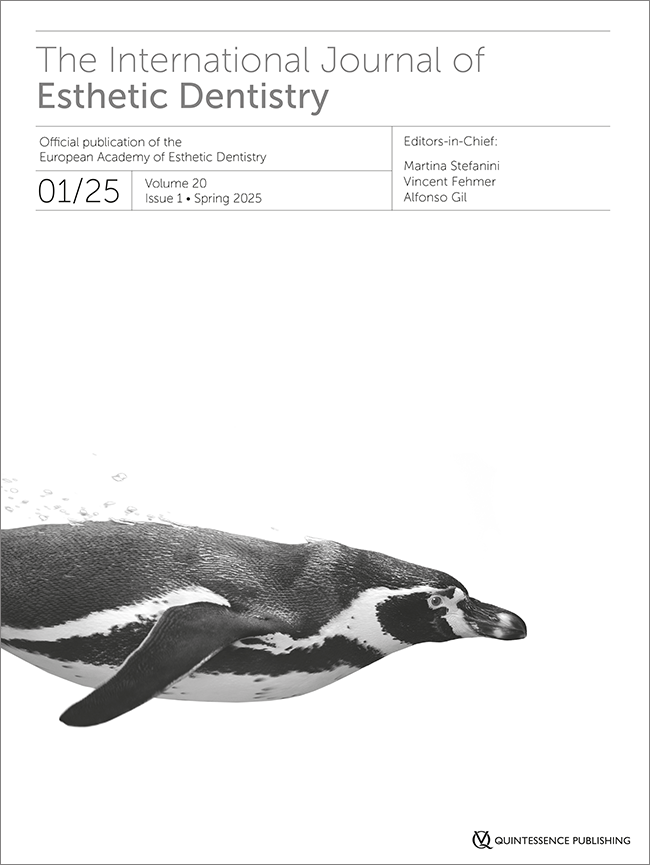International Journal of Periodontics & Restorative Dentistry, Pre-Print
DOI: 10.11607/prd.7346, PubMed ID (PMID): 3945362225. Oct 2024,Pages 1-20, Language: EnglishZucchelli, Giovanni / Mounssif, Ilham / Mazzotti, Claudio / Bentivogli, Valentina / Rendon, Alexandra / Sangiorgi, Matteo / Stefanini, MartinaImpairment or loss of interdental papilla is a common issue in patients with periodontal disease, leading to phonetic, functional, and aesthetic concerns. Numerous techniques have been explored to reconstruct and regenerate interdental papillae, but consistent success remains challenging. This article presents a novel surgical approach that applies the principles of the Connective Tissue Graft (CTG) wall technique to enhance papilla volume when interdental clinical attachment loss is present in the aesthetic zone. The case of a 35-year-old woman with an RT3 recession defect associated with loss of interdental hard and soft tissues is discussed. The patient underwent a procedure involving palatal incisions, application of amelogenins, and a trapezoidal shape CTG fixed at the base of the papilla under a coronally advanced flap. This approach aimed to stabilize the blood clot and prevent soft tissue collapse into the defect area, enhancing the position and volume of the interdental papilla. Results at 6- and 12-months follow-up indicated significant improvement in papilla appearance and complete root coverage. This case suggests that the modified CTG wall technique can effectively treat buccal and interdental gingival recessions associated with horizontal or infrabony defects. Further clinical trials are necessary to confirm these findings and establish the most effective approach for interdental papilla reconstruction.
Keywords: interdental papilla, connetive tissue graft, periodontal therapy, amelogenins, connective tissue graft-wall technique, papilla reconstruction
International Journal of Esthetic Dentistry (EN), 1/2025
EditorialPubMed ID (PMID): 39950381Pages 7-8, Language: EnglishStefanini, MartinaInternational Journal of Esthetic Dentistry (DE), 1/2025
EditorialPages 7-8, Language: GermanStefanini, MartinaInternational Journal of Periodontics & Restorative Dentistry, 3/2023
DOI: 10.11607/prd.6538, PubMed ID (PMID): 37141083Pages 281-288, Language: EnglishTavelli, Lorenzo / Heck, Teresa / De Souza, André B / Stefanini, Martina / Zucchelli, Giovanni / Barootchi, ShayanImplant esthetic complications can negatively affect a patient's perception of implant therapy and their quality of life. This article discusses the etiology, prevalence, and strategies for the treatment of peri-implant soft tissue dehiscences/deficiencies (PSTDs). Three common scenarios of implant esthetic complications were identified and described, in which PSTDs could be managed without removing the crown (scenario I), with the surgical-prosthetic approach (crown removal; scenario II), and/or with the horizontal and vertical soft tissue augmentation and submerged healing (scenario III).
International Journal of Esthetic Dentistry (DE), 2/2023
EditorialPages 115-116, Language: GermanStefanini, MartinaInternational Journal of Esthetic Dentistry (EN), 2/2023
EditorialPubMed ID (PMID): 37166765Pages 109-110, Language: EnglishStefanini, MartinaInternational Journal of Esthetic Dentistry (EN), 1/2023
EditorialPubMed ID (PMID): 36734420Pages 9-10, Language: EnglishFehmer, Vincent / Gil, Alfonso / Stefanini, MartinaInternational Journal of Esthetic Dentistry (DE), 1/2023
EditorialPages 7-8, Language: GermanFehmer, Vincent / Gil, Alfonso / Stefanini, MartinaInternational Journal of Periodontics & Restorative Dentistry, 3/2022
DOI: 10.11607/prd.5268Pages 393-399, Language: EnglishTavelli, Lorenzo / Barootchi, Shayan / Siqueira, Rafael / Kauffmann, Frederic / Majzoub, Jad / Stefanini, Martina / Zucchelli, Giovanni / Wang, Hom-LayAutogenous soft tissue grafting is a commonly performed procedure in periodontal and implant surgery. Reharvesting a connective tissue graft (CTG) from the same palatal donor site is often required, but little is known about the volumetric changes that occur after harvesting a free gingival graft and how long the palatal mucosa takes to regain its original form and thickness. This study evaluated the volumetric changes that occur at the palatal donor site after harvesting a soft tissue graft with a noninvasive digital technology. Nineteen patients needing a CTG for a single site were enrolled. Intraoral digital scans of the palatal donor sites were obtained at baseline and at 1, 3, 6, and 12 months. The digital scans were imported and analyzed with an imaging software to evaluate volumetric changes. Average volume losses of 5.82 ± 2.63 mm3 and 11.03 ± 5.47 mm3 were observed after 1 and 3 months, respectively. Only minor changes were observed at 6 and 12 months. Linear dimensional changes at 5 and 7 mm from the gingival margin were substantially higher than the changes at 3 mm for the 1- and 3-month interval comparisons compared to baseline. Graft dimension was associated with volume loss at 1 and 3 months (P < .01). After palatal harvesting, the donor site undergoes volumetric changes, mostly during the first 3 months, and is attenuated thereafter.
International Journal of Esthetic Dentistry (EN), 2/2022
EditorialPubMed ID (PMID): 35586994Pages 135-136, Language: EnglishStefanini, Martina





